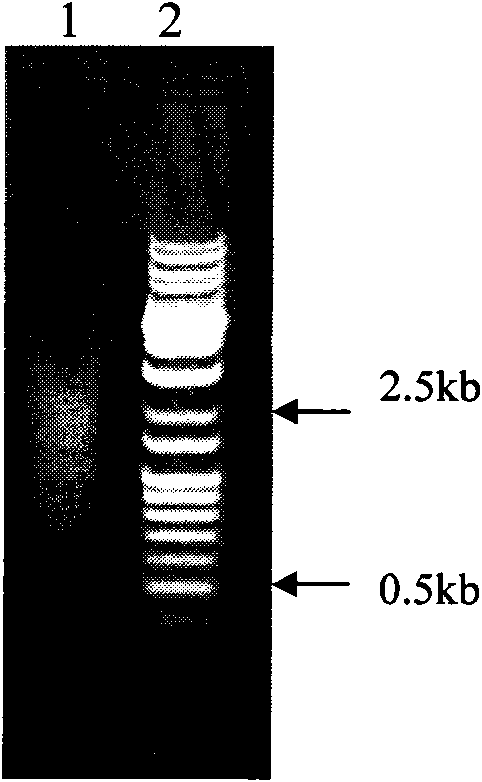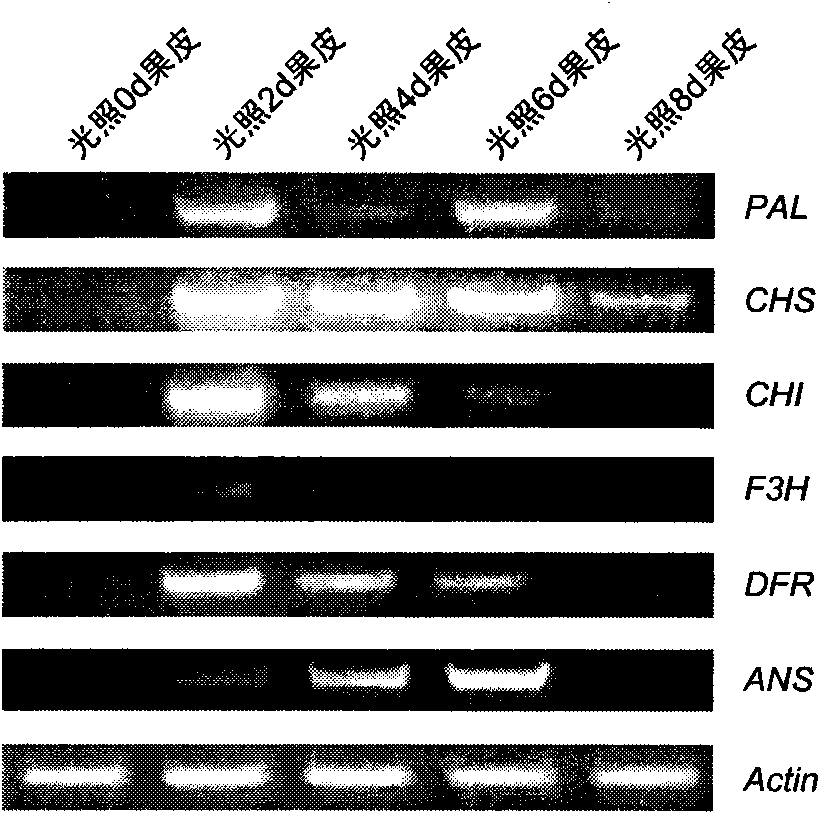Method for extracting total RNA from plant tissue rich in polysaccharides and polyphenols and secondary metabolites
A plant tissue and secondary metabolism technology, applied in the field of plant molecular biology, can solve the problems of long time, many processing steps, and the ineffectiveness of conventional methods, and achieve the effect of improving quality and inhibiting obstacles.
- Summary
- Abstract
- Description
- Claims
- Application Information
AI Technical Summary
Problems solved by technology
Method used
Image
Examples
Embodiment 1
[0038] Example 1: Extraction and application of total RNA from young leaves (red), colored pericarp and uncolored pericarp of Yunnan Hongpi pear
[0039] (1) Take 1 g each of the young leaves (red), colored peel, and uncolored peel of Yunnan red-skinned pears quick-frozen in liquid nitrogen, and grind them into powder with liquid nitrogen; quickly transfer the sample to a centrifuge tube, and add 10mL pre-cooled RNA extraction buffer, mix well and place on ice for 5min, then add 3mol L of pH4.5 -1 Sodium acetate 1mL, mix upside down;
[0040] (2) Then add 11 mL of chloroform, shake vigorously to mix the two phases, place on ice for 10 min, then centrifuge at 12,000 g at 4°C for 10 min, and take the supernatant into a new centrifuge tube;
[0041] (3) Repeat the chloroform extraction step in (2) once;
[0042] (4) Add 10mL of isopropanol to the supernatant, mix well, place at -20°C for 30min, then centrifuge at 12000g at 4°C for 15min to obtain RNA precipitation;
[0043] (5...
Embodiment 2
[0079] Embodiment 2: grape young leaves, young fruit pericarp, pulp total RNA extraction
[0080] (1) Take 1.2 grams each of liquid nitrogen quick-frozen grape leaves, young fruit peels, and pulp, and grind them into powder with liquid nitrogen; quickly transfer each sample to a centrifuge tube, and add 12 mL of pre-cooled RNA extraction buffer , mix well and place on ice for 5min, then add 3mol L of pH4.5 -1 Sodium acetate 1.2mL, mix up and down;
[0081] (2) Then add 13mL chloroform, shake vigorously to mix the two phases, place on ice for 10min, centrifuge at 12000g at 4°C for 10min, take the supernatant into a new centrifuge tube;
[0082] (3) Repeat the chloroform extraction step in (2) once;
[0083] (4) Add 12mL of isopropanol to the supernatant, mix well, place at -20°C for 30min, then centrifuge at 12000g at 4°C for 15min to obtain RNA precipitation;
[0084] (5) Wash the precipitate twice with 75% ethanol, dry at room temperature for 20min, and then use 1.2mL DEPC...
Embodiment 3
[0092] Embodiment 3: strawberry immature fruit (green) and ripe fruit (red) total RNA extraction
[0093] (1) Take liquid nitrogen quick-frozen strawberry immature fruit and 2 grams of mature fruit, and grind it into powder with liquid nitrogen; quickly transfer each sample to a centrifuge tube, and add 20 mL of pre-cooled RNA extraction buffer, Mix well and place on ice for 5min, then add 3mol L of pH4.5 -1 Sodium acetate 2mL, mix up and down;
[0094] (2) Then add 22mL of chloroform, shake vigorously to mix the two phases, place on ice for 10min, then centrifuge at 12000g at 4°C for 10min, and take the supernatant into a new centrifuge tube;
[0095] (3) Repeat the chloroform extraction step in (2) once;
[0096] (4) Add 20mL of isopropanol to the supernatant, mix well, place at -20°C for 30min, then centrifuge at 12000g at 4°C for 15min to obtain RNA precipitation;
[0097] (5) Wash the precipitate twice with 75% ethanol, dry it at room temperature for 20 min, and then u...
PUM
 Login to View More
Login to View More Abstract
Description
Claims
Application Information
 Login to View More
Login to View More - R&D
- Intellectual Property
- Life Sciences
- Materials
- Tech Scout
- Unparalleled Data Quality
- Higher Quality Content
- 60% Fewer Hallucinations
Browse by: Latest US Patents, China's latest patents, Technical Efficacy Thesaurus, Application Domain, Technology Topic, Popular Technical Reports.
© 2025 PatSnap. All rights reserved.Legal|Privacy policy|Modern Slavery Act Transparency Statement|Sitemap|About US| Contact US: help@patsnap.com



